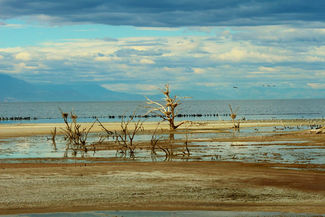The Salton Sea is Precariously Slipping Away
Last updated 7/21/2015 at 10:39am
The Salton Sea was accidentally created in 1905 when engineers dug irrigation canals from the Colorado River. Water then poured into the Salton Basin for two years before they could make the necessary repairs. The Salton Sea is now the largest lake in California, home to over 400 species of birds and a key stopover spot for migrating birds on the Pacific Flyway. The sea was once a popular fishing spot but now clumps of dead fish clog stretches of the surreal coastline. The receding sea is taking its toll and evaporation and stagnation have created a lake that is 50 % saltier than the actual ocean. With changes in water apportionments for the Colorado River, the level of the sea will decrease even more significantly as water agencies quit replenishing the salty water in 2017. The greatest concern about the shrinking sea has to do with all the toxic materials that have accumulated at the bottom of the sea from agricultural runoff. Many experts agree that once the toxic dust gets to traveling toward large urban areas, to say nothing of the smaller communities nearby, the situation could be catastrophic. Communities along the Salton Sea already have the highest asthma rates in the state. Ecologist Bruce Wilcox recently told the Washington Post that dried lake-bed material, called 'playa', flies away more easily than soil and when driven by desert winds "could seed health problems for 650,000 people as far away as Los Angeles."
Wilcox mentioned the Owens River Valley as a warning of what could happen with the Salton Sea. Lake Owens was drained by the L.A. aqueduct nearly one hundred years ago, but the dry lake-bed remains the number one source of dust in the United States.









